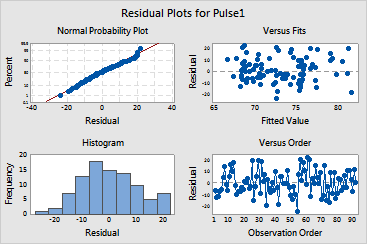
Use to examine the goodness of model fit in regression and ANOVA. Examining residual plots helps you determine if the ordinary least squares assumptions are being met. If these assumptions are satisfied, then ordinary least squares regression will produce unbiased coefficient estimates with the minimum variance. Minitab provides the following residual plots:
|
|
Histogram of the Residuals. An exploratory tool to show general characteristics of the residuals including typical values, spread, and shape. A long tail on one side may indicate a skewed distribution. If one or two bars are far from the others, those points may be outliers.
Normal Probability Plot of residuals. The points in this plot should generally form a straight line if the residuals are normally distributed. If the points on the plot depart from a straight line, the normality assumption may be invalid.
Residuals Versus Fitted Values. This plot should show a random pattern of residuals on both sides of 0. If a point lies far from the majority of points, it may be an outlier. There should not be any recognizable patterns in the residual plot. For instance, if the spread of residual values tend to increase as the fitted values increase, then this may violate the constant variance assumption.
Residuals Versus Order of Data. This is a plot of all residuals in the order that the data was collected and can be used to find non-random error, especially of time-related effects. This plot helps you to check the assumption that the residuals are uncorrelated with each other
|
Residuals versus predictors. This is a plot of the residuals versus a predictor. This plot should show a random pattern of residuals on both sides of 0. Non-random patterns, such as the example to the right, may violate the assumption that predictor variables are unrelated to the residuals. You may have used an incorrect functional form to model the curvature. |
Residual |
|
|
|
|
Predictor |